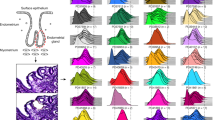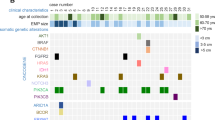Abstract
Several genetic mutations have been identified in human endometrial cancers, but the specific combinations of mutations required to form endometrial cancer cells remain unknown. In the present study, we established an in vitro model of endometrial carcinogenesis, in which defined genetic elements were introduced into endometrial epithelial cells to create transformed endometrial cells at different stages. Introduction of the human papillomavirus type 16 E6/E7 gene and the human telomerase reverse transcriptase (hTERT) gene into human primary endometrial epithelial cells was sufficient to generate immortalized cells. Introduction of hTERT in early passages stabilized telomeres and created immortalized cells with normal karyotype, whereas introduction of hTERT in later passages generated immortalized cells but with widespread chromosome abnormalities. However, neither of those two immortalized cell lines exhibited tumorigenic phenotypes. Tumorigenic endometrial epithelial cells with invasive capacity were created by introducing a mutant K-ras allele into immortalized cells, keeping their chromosomes intact. Inhibiting the PTEN gene and activating Akt pathways did not create tumorigenic phenotypes, although the latter conferred anchorage-independent growth capacity. These findings suggest that neoplastic transformation of human endometrial cells can occur in the absence of widespread chromosomal abnormality, and that the combination of Rb inactivation, telomerase activation and altered K-ras signaling is sufficient for in vitro neoplastic transformation. The present experimental model can help clarify the genetic requirements for endometrial carcinogenesis, and it is useful for testing and developing specific inhibitors of specific oncogenic pathways.
This is a preview of subscription content, access via your institution
Access options
Subscribe to this journal
Receive 50 print issues and online access
$259.00 per year
only $5.18 per issue
Buy this article
- Purchase on Springer Link
- Instant access to full article PDF
Prices may be subject to local taxes which are calculated during checkout







Similar content being viewed by others
References
Akoum A, Doillon CJ, Koutsilieris M, Dompierre L, Maheux R, Villeneuve M et al. (1996). J Reprod Med 41: 555–561.
Arnold JT, Kaufman DG, Seppala M, Lessey BA . (2001). Hum Reprod 16: 836–845.
Artandi SE, DePinho RA . (2000). Curr Opin Genet Dev 10: 39–46.
Berger R, Febbo PG, Majumder PK, Zhao JJ, Mukherjee S, Signoretti S et al. (2004). Cancer Res 64: 8867–8875.
Boland CR, Thibodeau SN, Hamilton SR, Sidransky D, Eshleman JR, Burt RW et al. (1998). Cancer Res 58: 5248–5257.
Chin L, Artandi SE, Shen Q, Tam A, Lee SL, Gottlieb GJ et al. (1999). Cell 97: 527–538.
Classen-Linke I, Kusche M, Beier HM . (1997). Cell Tissue Res 287: 171–185.
Enomoto T, Inoue M, Perantoni AO, Buzard GS, Miki H, Tanizawa O et al. (1991). Cancer Res 51: 5308–5314.
Freeman DJ, Li AG, Wei G, Li HH, Kertesz N, Lesche R et al. (2003). Cancer Cell 3: 117–130.
Hahn WC, Counter CM, Lundberg AS, Beijersbergen RL, Brooks MW, Weinberg RA . (1999). Nature 400: 464–468.
Hirasawa A, Aoki D, Inoue J, Imoto I, Susumu N, Sugano K et al. (2003). Clin Cancer Res 9: 5675–5682.
Inoue M . (2001). Int J Gynecol Cancer 11: 339–348.
Kanaya T, Kyo S, Sakaguchi J, Maida Y, Nakamura M, Takakura M et al. (2005). Am J Clin Pathol 124: 1–8.
Katabuchi H, van Rees B, Lambers AR, Ronnett BM, Blazes MS, Leach FS et al. (1995). Cancer Res 55: 5556–5560.
Kiyono T, Foster SA, Koop JI, McDougall JK, Galloway DA, Klingelhutz AJ . (1998). Nature 396: 84–88.
Kohn AD, Summers SA, Birnbaum MJ, Roth RA . (1996). J Biol Chem 271: 31372–31378.
Kyo S, Nakamura M, Kiyono T, Maida Y, Kanaya T, Tanaka M et al. (2003). Am J Pathol 163: 2259–2269.
Levine RL, Cargile CB, Blazes MS, van Rees B, Kurman RJ, Ellenson LH . (1998). Cancer Res 58: 3254–3258.
Maehama T, Dixon JE . (1998). J Biol Chem 273: 13375–13378.
Maxwell GL, Risinger JI, Gumbs C, Shaw H, Bentley RC, Barrett JC et al. (1998). Cancer Res 58: 2500–2503.
Mutter GL, Wada H, Faquin WC, Enomoto T . (1999). Mol Pathol 52: 257–262.
Niemann TH, Yilmaz AG, McGaughy VR, Vaccarello L . (1997). Gynecol Oncol 65: 232–236.
Sato H, Takino T, Okada Y, Cao J, Shinagawa A, Yamamoto E et al. (1994). Nature 370: 61–65.
Sawada M, Kiyono T, Nakashima S, Shinoda J, Naganawa T, Hara S et al. (2004). Cell Death Differ 11: 997–1008.
Semczuk A, Miturski R, Skomra D, Jakowicki JA . (2004). Arch Gynecol Obstet 269: 104–110.
Sonoda G, du Manoir S, Godwin AK, Bell DW, Liu Z, Hogan M et al. (1997). Genes Chromosomes Cancer 18: 115–125.
Stambolic V, Suzuki A, de la Pompa JL, Brothers GM, Mirtsos C, Sasaki T et al. (1998). Cell 95: 29–39.
Tang X, Powelka AM, Soriano NA, Czech MP, Guilherme A . (2005). J Biol Chem 280: 22523–22529.
Tashiro H, Blazes MS, Wu R, Cho KR, Bose S, Wang SI et al. (1997). Cancer Res 57: 3935–3940.
Zhao JJ, Gjoerup OV, Subramanian RR, Cheng Y, Chen W, Roberts TM et al. (2003). Cancer Cell 3: 483–495.
Zimonjic D, Brooks MW, Popescu N, Weinberg RA, Hahn WC . (2001). Cancer Res 61: 8838–8844.
Acknowledgements
This study was supported by in part by a Grant-in Aid for scientific research from the Japan Society for the Promotion of Science, and by Megumi Medical Foundation in Kanazawa University.
Author information
Authors and Affiliations
Corresponding author
Rights and permissions
About this article
Cite this article
Mizumoto, Y., Kyo, S., Ohno, S. et al. Creation of tumorigenic human endometrial epithelial cells with intact chromosomes by introducing defined genetic elements. Oncogene 25, 5673–5682 (2006). https://doi.org/10.1038/sj.onc.1209575
Received:
Revised:
Accepted:
Published:
Issue Date:
DOI: https://doi.org/10.1038/sj.onc.1209575
Keywords
This article is cited by
-
Endometrial Cancer Stem Cells: Are They a Possible Therapeutic Target?
Current Obstetrics and Gynecology Reports (2013)



